Palm Vein Recognition – the "Fingerprint Unlock 2.0" of Biometrics – is Revolutionizing Identity Authentication. Yet, the limited scale of existing palm vein databases has become a major roadblock for technological advancement. Enter PVTree, a groundbreaking synthetic palm vein method developed by our school’s research team. PVTree leverages 3D modeling to generate ultra-realistic vein patterns, then employs a "multi-angle projection" technique to create diverse synthetic samples. The result? A scalable pipeline for high-quality, large-scale vein databases. The real surprise? Recognition models trained on this AI-synthesized vein data achieved higher accuracy than those trained on real-world datasets – a world-first milestone! This "AI magic show" of synthetic-vs-real performance was spotlighted at AAAI 2025 (the Association for the Advancement of Artificial Intelligence), held in Philadelphia, USA. The work, presented as an Oral Presentation, features 2023 MSc student Sheng Shang as first author, with Professor Wei Jia as corresponding author. The research was conducted by Prof. Jia’s team at our school.
Paper Title: PVTree: Realistic and Controllable Palm Vein Generation for Recognition Tasks
Authors: Sheng Shang, Jianlong Jin, Yang Zhao, Wei Jia et al.
Paper Link: https://arxiv.org/abs/2503.02547

Figure 1: The overall process of our method

Figure 2: Pipeline of the proposed method. Firstly, PVTree Model is used to generate a palm vascular tree, which starts from the trunk representing vein types that we have summarized, and an authentic 3D palm vascular tree is obtained through the Constrained Constructive Optimization (CCO) and Trajectory Simulation Mechanism (TSM). Then Multi-views project, crop, and blend it with the Bezier creases (Zhao et al. 2022) representing palmprint to obtain the palm vein patterns representing ´ identity. Finally, by improving the noise sampling mechanism of PCE-Palm, diverse palm vein images are generated.

Table1: Recognition performance on real datasets and synthetic datasets under different settings
Abstract: Palm vein recognition is an emerging biometric technology that offers enhanced security and privacy. However, acquiring sufficient palm vein data for training deep learning-based recognition models is challenging due to the high costs of data collection and privacy protection constraints. This has led to a growing interest in generating pseudo-palm vein data using generative models. Existing methods, however, often produce unrealistic palm vein patterns or struggle with controlling identity and style attributes. To address these issues, we propose a novel palm vein generation framework named PVTree. First, the palm vein identity is defined by a complex and authentic 3D palm vascular tree, created using an improved Constrained Constructive Optimization (CCO) algorithm. Second, palm vein patterns of the same identity are generated by projecting the same 3D vascular tree into 2D images from different views and converting them into realistic images using a generative model. As a result, PVTree satisfies the need for both identity consistency and intra-class diversity. Extensive experiments conducted on several publicly available datasets demonstrate that our proposed palm vein generation method surpasses existing methods and achieves a higher T AR@F AR = 1e − 4 under the 1:1 Open-set protocol. To the best of our knowledge, this is the first time that the performance of a recognition model trained on synthetic palm vein data exceeds that of the recognition model trained on real data, which indicates that palm vein image generation research has a promising future.
AAAI (Association for the Advancement of Artificial Intelligence) is one of the oldest and most comprehensive international top-tier conferences in AI, recognized as a CCF Rank-A academic conference (the highest classification by the China Computer Federation). Only the highest-quality papers are selected for Oral Presentations—a mark of exceptional rigor and innovation. At AAAI 2025, over 3,000 papers were accepted, with merely 600 (20%) earning the Oral Presentation distinction. Our school's work stood among this elite group, underscoring its groundbreaking contributions to palm vein recognition technology.
 TOP
TOP